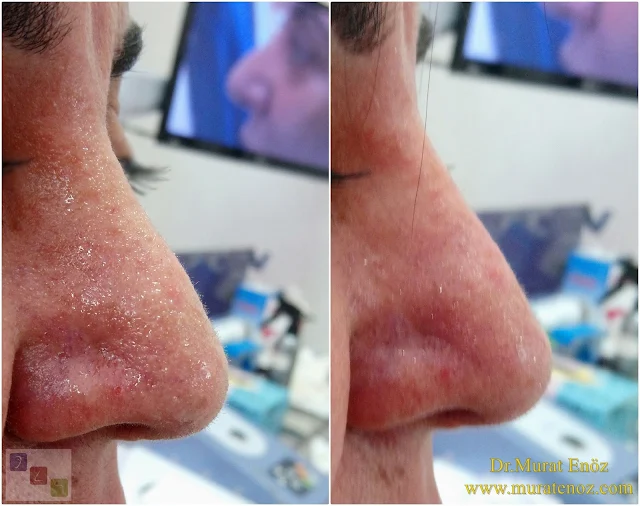Non-Surgical Correction of Pollybeak Deformity with Nose Filler Injections
Pollybeak Deformity is a complication of rhinoplasty operation, with the appearance of a bird beak-like appearance when viewed nasally, particularly on the side. The Cartilage Pollybeak Deformity and Soft Tissue Pollybeak Deformity can be divided into two.In the above and in the following photos, the filling contains injected hyaluronic acid with cross-linked hyaluronic acid to the patient's Pollybeak Deformity and has pre- and post-injection views.
Although there is no permanent treatment; It is an alternative to surgical treatment.
Links to more detailed information about this topic >> Soft Tissue Pollybeak Deformity / Pollybeak Deformity - Definition, Causes, Classification, Treatment
The non-surgical nose shaping treatment with nose filler that I offer here is only for patients who do not want surgery and prefer this treatment method, even if it is temporary. As seen here, most asymmetries related to pollybeak nose deformity in the nose were corrected in just a few minutes with HA filler injection in office conditions. Our patient informs us that the beak nose shape emerged after a rhinoplasty previously performed in another clinic. This patient was normally recommended a revision rhinoplasty operation (coarse cartilage may be stretched). The patient accepted this procedure, which takes a few minutes, to be repeated instead of a surgical procedure. I generally do not prefer permanent nose fillers and prefer to use HA fillers, which have been used in medical treatment for many years.
Treatment of Pollybeak Deformity With Filler Video
The patient above had applied for treatment for polly beak deformity that had developed after a rhinoplasty operation performed at a different clinic. We also injected HA filler into this patient in the office, and even after just a few injections, a much more natural-looking nose shape emerged.
Murat Enoz, MD, Otorhinolaryngology, Head and Neck Surgeon - ENT Doctor in Istanbul
Private Office:
Address: İncirli Cad. No:41, Kat:4 (Dilek Patisserie Building), Postal code: 34147, Bakırköy - İstanbul
Appointment Phone: +90 212 561 00 52
Appointment Phone: +90 212 561 00 52
Fax: +90 212 542 74 47





Is this the solution for all pollybeak what if your tip is weak.i have been having non surgical nose job elsewhere .seem to be focusing in more filler in septum to life.it looks nice for few weeks and then end up with bulkier tip .is it weighing it down and should avoid tip area completely and should be done like in the video .to work on bridge only?
ReplyDeleteHello, the nose filler process done here is only done for the purpose of filling the dorsum of the nose, so there is no filling, especially in the nose tip or in the supratip area. It is already effective in a very limited time when nasal fillings are used to manage the nose tip upwards, but when the non surgical nose job process is performed repeatedly to the dorsum of the of the nose, pollybeak nasal deformity is also become less visible in timely. long-term positive results can be obtained. Of course, although it does not have a permanent effect like a surgical procedure; It is preferred because it is practical and changes in nose shape in a short time in patients.
DeleteThank you for replying I think my polybeak has been too overdone to use this technique my nasal tip really droops was trying to come up with a solution to improve its appearance but not sure this will work and like more aesthetically pleasing
DeleteOf course, in patients with Polly beak deformity, surgical treatment may be more appropriate for a permanent and more satisfying nose shape. For this purpose, the tip of the nose can be lifted up and to the side and the supratip region can be reduced. In patients with weak nasal support, additional cartilage grafts can be used in patients who have had previous surgery to reconstruct the nasal cartilages. In patients with very thick skin features, bilevel dissection and subcutaneous tissue resection can be performed to thin the skin. some physicians may prescribe retinoid-derived tablets and topical creams before and after surgery. Again, various tapes and casts can be used to put pressure on the nasal skin after the surgery. Repeated cortisone injections can sometimes be beneficial, especially in patients with excessive skin edema in the supratip region. Thank you for your interest in my website. I will gladly reply. Greetings from Istanbul. Dr. Murat Enoz
ReplyDelete